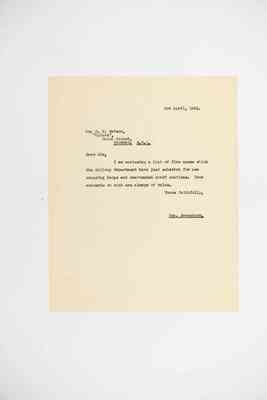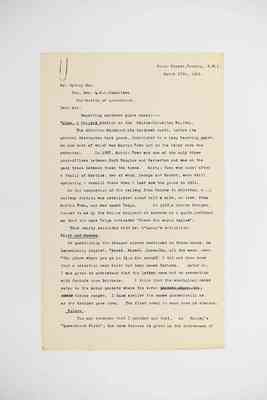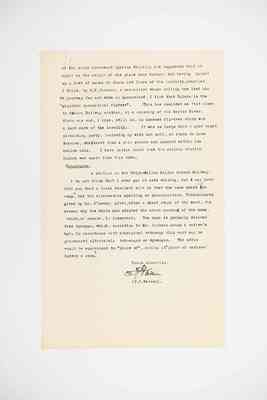Pages
41
From this I would say the correct spelling would be Beachmere, and, situated between seven and eght miles from the township of Caboolture, at the mouth of the Caboolture River, was the homestead built by the first settler, a Mr. Bonney, in the year 1870.
I feel sure you will find this information most correct."
----
The above letter was forwarded to me as a reply to a letter of inquiry addressed by me to Mr W. Smith of Caboolture.
Mr. Smith handed my letter to Mrs. Smith for reply evidently for the reason of her life-long acquaintance of the locality in question.
Yours faithfully, [signature] (F.J. Watson).
42
Union Street, [Toowong], S.W.1. 7th April, 1941.
[Mr. Sydney May], Hon. Secretary, Q.P.N.Committee, University of Queensland,
Dear Sir,
I have your letter of 3rd April to hand. Regarding the list of place names therewith,-- I have no knowledge of the suggested names Mangool,Calebra, Pombel and Bubialo,they being foreign to any of the languages with which I am acquainted.
The name Cuppie, is, I presume, meant for the Brisbane River name of the grey opossum, but the name ,as spelled, gives a wrong impression as to pronunciation. Better spelling would be Kupi, or Koopi, as the first vowel should be sounded as in English coop (as in hen-coop) and the last vowel short as in English it, and not as ee. On objection to the use of this name is that a railway station on the Isis Railway has the same meaning although is wrongly spelled as Kowbi. In place of this name I might suggest Narambi, which has the same meaning.
Another sugestion for the name of a cross-over is Wangau which in the Kabi language means a "crossing"or"across."
Your sincerely [FJWatson] ([F.J.Watson])
43
3rd April, 1941.
[Mr. F. J. Watson], "Nyleta", Union Street, TOOWONG. S.W.1.
Dear Sir,
I am enclosing a list of five names which the Railway Department have just selected for new crossing loops and unattended staff stations. Your comments on such are always of value.
Yours faithfully,
Hon. Secretary.
44
Union Street, [Toowong], S.W.1. March 27th, 1941.
[Mr. Sydney May], Hon. Sec. Q.P.N.Committee, University of Queensland.
Dear Sir,
Regarding northern place names;---
[Tolga], a railway station on the Cairns-Herberton Railway.
The [Athertone Scrub] at its farthest north, before its general destructon took place, diminished to a long tapering point, on one side of which was [Martin Town] and on the other side was [Atherton]. In 1886, [Martin Town] was one of the only three post-offices between [Port Douglas] and [Herberton] and was on the pack track between these two towns. [Martin Town] was named after a family of Martins, two of whom, [George Martin]and [Robert Martin], were still operating a sawmill there when I last saw the place in 1911.
On the completion of the railway from [Cairns] to [Atherton], a railway station was established about half a mile, or less, from [Martin Town], and was named [Tolga]. In 1910,a native trooper, loaned to me by the Police Sergeant at [Mareeba] as a guide,informed me that the name Tolge indicated "where the scrub begins".
This nearly coincides with [Mr. O'Leary]'s definition.
Kairi and [Kureen?].
In questioning the trooper above mentioned on these names, he laconically replied, "Kareé, Kareém ,Kareeńda; all the same, mean "the place where you go in (i.e.the scrub)". I did not then know that a selection near [Kairi] had been named [Corinda]. Later on, I was given to understand that the latter name had no connection with [Corinda] near [Brisbane]. I think that the aboriginal names refer to the scrub pockets where the scrub pockets where the scrub blacks camped. I have spelled the names phonetically,as as the trooper gave them. The first vowel in each case is obscure.
Kulara .
You may remember that I pointed out that, in [Bailey]'s "Queensland Flora", the name Kalaara is given as the nativename of
45
of the scrub iron-wood (Myrtus Hillii), and suggested that it might be the origin of the place name Kulara. but having looked up a list of names of fauna and flora of the locality, compiled, I think, by S.W. Jackson, a naturalist whose calling has lead him to journey far and wide in Queensland, I find that Kulara is the "gigantic parasitical figtree". This has reminded me that close to Kulara Railway station, at a crossing of the Barron River, there was and, I hope, still is, an immense fig-tree which was a land mark of the locality. It was so large that a good sized picnicking party, including my wife and self, en route to Lake Barrine, sheltered from a rain shower and lunched within its hollow bole. I have little doubt that the railway station Kulara was named from this tree.
Yungaburra.
A station on the Tolga-Millaa Millaa Branch Railway. I do not think that I ever put it into writing, but I may have told you that a local resident told me that the name meant "Fox camp", but the alternative spelling or pronunciation, Tchankaburra given by Mr. O'Leary, gives, after a short study of the word, the reason why the white men adopted the above meanning of the name, which, of course, in incorrect. The name is probably derived from tuangun, which, according to Mr. Jackson means a native's hut. In accordance with aboriginal orthoepy this word may be pronounced alternately tchuangun or dyuangan. The affix would be equvalent to "place of", make it "place of natives' huts or a camp".
Yours sincerely, [signature] (F.J. Watson).




